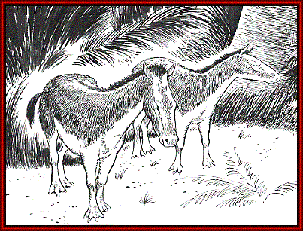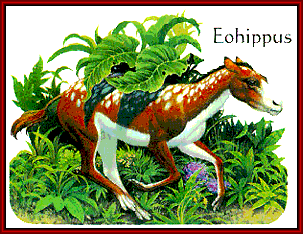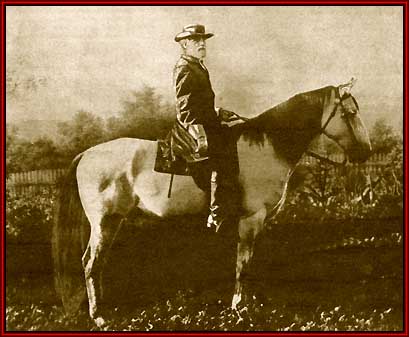|
|
|
|
 |
Hyracotherium
These small ancestors of modern horses were half a metre or less in length -- about the size of a fox terrier. Compared
to living horses, their legs were shorter, they had longer heads
relative to their bodies, and a more complete series of teeth. They
had three toes on their hind feet and four on their forefeet. Each
toe had a pad on its underside, like dogs have. Modern horses have
long legs, each ending in a single, powerful toe with a hoof -- but
no pad. Eohippus lived during the early part of the Tertiary (about
50 million years ago). Although these dawn horses were present in
Europe as well as North America, the mainstream of horse evolution
occurred on the latter continent. |
|
EXCERPT: Stephen Budiansky's new book, The Nature of Horses
In a chapter about
the evolution of the horse he talks about the evolution of size and
speed:
"The usual explanation for these changes, and for the eventual
appearance of the single-toed foot in Pliocene horses (beginning 5
million years ago) is that, as grassland animals, these grazing horses
were more exposed to predators and had to be able to flee. The
evolution of the diastema may be related to this fact too: a long
distance between the front of the mouth and the eyes allows an animal to
graze and keep an eye out at the same time.
There is no doubt that larger animals are faster and that the springing
hoof allowed for a faster gait. The almost unbelievable discovery
of fossil footprints of three Hipparion horses from the middle Pliocene
(3.5 Million Years ago) have provided ample confirmation of the sped and
agility of these grasslands-adapted horses. Although Hipparion
still had three toes on each foot, it had already developed the
springing foot mechanism; and in spite of its relatively small
size, its overall proportions-leg length relative to body size, for
instance- are quite similar to those of modern horses.
The two side toes
in Hipparion species, while able to help balance the foot and even add
some to the locomotive effort, were already much reduced in size
compared to those of their ancestors, and clearly most of the work was
done by the large central toe. The Hipparion footprints, made in
soft lava subsequently covered with volcanic ash, were discovered in
Tanzania by Mary Leakey in 1979, along with trails of a number of other
mammals, including early hominids.
|
|
A subsequent analysis of the horse footprints makes a convincing
case that these Hipparion horses traveled a good clip utilizing
the gait known as the running walk-the
characteristic gait of Tennessee waking horses, Icelandic ponies,
and Paso Finos, in which the length of the stride is extended and
only one or two feet are in contact with the ground at any given
time. Comparison of the fossil footfalls with the footfall
patterns of Icelandic ponies suggests that one of the Hipparions
was traveling at 15 kilometers per hour. The two trails
appeared to be those of a mother and foal, the latter
crisscrossing the path of its mother in much the same fashion as
is observed in modern horses.
The finding incidentally provides at least some
suggestive evidence in support of the contention that the running
walk, though associated with only certain breeds these days, is
nonetheless an instinctive and natural gait, rather than (as is
sometimes argued) one that is artificial and man-taught" . |
 |
|
|
The Tennessee
Walking horse carries the blood of four distinct living breeds - the
Thoroughbred, Standardbred, American Saddlebred, and the Morgan, plus
two breeds that are virtually extinct - the Narragansett Pacer and the
Canadian Pacer. While English Thoroughbreds, Morgans,
Standardbreds and coach horses may all be found in the background of
Tennessee Walking horses, it was the Canadians and Narragansetts who
formed the basis for their gaits. The two earliest strains,
or breeds, of horses recognized in North America were the Canadian
Pacer, a breed still existing in small numbers in Canada, which evolved
from Norman horses brought to Quebec by French settlers; and the
now-extinct Narragansett Pacer, which evolved from British Hobbies and
Galloways brought to the American Colonies by English settlers.
|

TRAVELER, 1861 (General Robert E. Lee up)
Bred in Virginia, Traveler was bought by General Lee in 1861.
His breeding was probably of Thoroughbred, Morgan, and Narragansett
blood,
which flows through so many well known Tennessee Walking
Horses. |
About 150 years ago in American history, when the
hill people of Kentucky, Virginia and Tennessee crossed the
Mississippi River to settle the Ozark Mountain regions of Missouri
and Arkansas, they took with them their best horses. The
square trotting horses were able to cover the ground, but their gait
was uncomfortable, and tiring for both horse and rider within just a
few miles. The "Walking Saddle Horse," or "Plantation Horse"
as the Tennessee Walker was called then, would do a running walk,
and that was fast and comfortable. While the bloodlines of the
Gray Johns, Copperbottoms, Slashers, Hals, Brooks and Bullett
families ran thick and produced a type known as the Tennessee pacer
prior to the arrival of Allan F-1 in Middle Tennessee, it was a cross
between Allan and the Tennessee Pacer that produced today's Tennessee
Walking Horse. At this time, the most prominent saddle horse was
the now-extinct Narragansett Pacer, which originated around Narragansett
Bay, in Rhode Island.
|
|
|
|
|
To the North in the Canadian Provinces, French mares
were crossed with English and Dutch stock, to produce what became
known as the Canadian Pacer, a breed which still exists, but in very
small numbers in that country.
|
|
|
Then, the American Colonists began crossing their
gaited stock with the English Thoroughbreds. One famous
stallion was Hedgeford, imported in 1832, and his most remembered
son was Denmark.
|
|
|
Denmark was bred to a mare of Narragansett
background known as the Stevenson mare, from Cockspur bloodlines,
and their foal was Gaines Denmark. During his career, Gaines Denmark
produced four legendary sons, and in 1908, the American Saddle Horse
Breeder's Association named him THE single foundation sire of the
Saddle Horse breed. Previous lists had included such horses as
Harrison Chief, Tom Hal and Copperbottom.
|
|
|
Understandably, as harness racing became popular
with Colonial gentlemen, these horses made their way towards the
colonies of Kentucky, Virginia and Tennessee. Inevitably, as frontiers
moved south and west, the Narragansett and Canadian Pacers came
together. The Canadians went to New England, where they became a part of
the foundation of what is now the Morgan breed.
|
|
|
The Tennessee Walking Horse was derived in
Tennessee, primarily from the American Trotting Horse with the
heavy influence of the Morgan Horse and the Canadian Pacer.
The American Trotting Horse is now known as the Standardbred.
|
|
|
The war Between the States occasioned the
crossbreeding of the Confederate Pacer and Union Trotters: thus the
Southern Plantation Walking Horse or Tennessee Pacer came into
being. Next came the blood of the Thoroughbred,
Standardbred, Morgan and the American Saddlebred. All were
fused into one animal in the middle of Tennessee bluegrass region.
The result, over countless years, was the "world's greatest show,
pleasure, and trail horse,"- the first breed of the horse to bear a
state name - the Tennessee Walking Horse.
|
|
|
|
|
|
|
|
|
|
|
|





